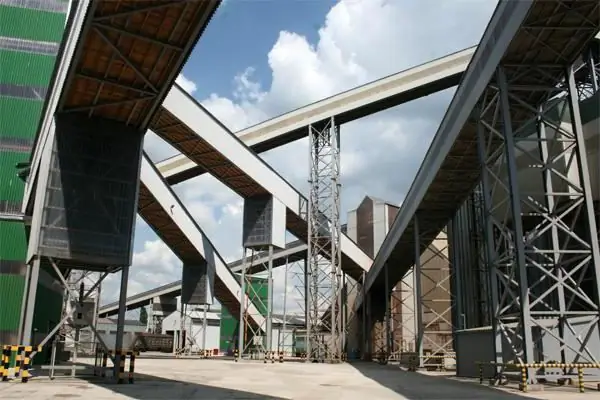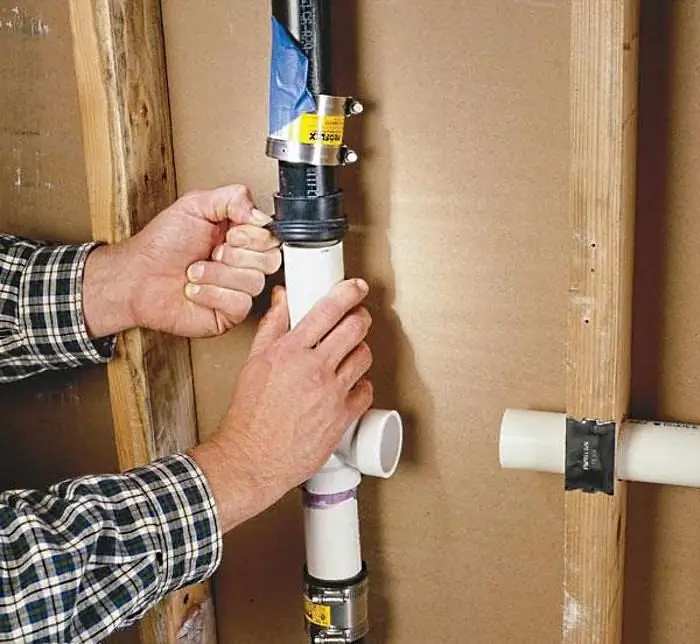2025 Author: Howard Calhoun | [email protected]. Last modified: 2025-01-24 13:10:31
Metal as one of the most popular building materials is also of great interest in terms of technical and structural development. Its functional qualities expand the possibilities of construction and installation works, allowing the construction of objects with a combination of seemingly contradictory performance characteristics. A striking example of such materials is light metal structures (LMK), which are used to construct low-rise technical and utility facilities.

LMC manufacturing technology
As a raw material for light building metal structures, black metal is used, from which beams, ceilings, sheet products, ladder modules, etc. are produced. In the manufacture, stamping, welding, grinding, cutting, bending and other mechanical operations and thermalworkpiece processing. The use of both hot rolling and cold rolling is practiced. For example, the Kansk plant of light metal structures "Mayak" specializes in cold working, producing sheet metal, pipes, channel bars, metal tiles and other products for various needs of industry and construction. No less widely represented by Russian enterprises are products manufactured using hot-rolled processing methods. In this way, products with increased strength and accuracy of geometric shape are obtained. Welding technologies also make it possible to form complex structures ready for installation without special modifications on the construction site.
Varieties of light steel structures

There is a fundamental difference between ordinary light (LMK) and light thin-walled metal structures, in the manufacture of which only steel is used. Moreover, if the first group of products does not necessarily comply with the principles of optimization in terms of mass and dimensions, then the second one fully fits into this concept. Lightweight thin-walled structures just allow the construction of frame prefabricated structures that require minimal financial and physical investments. In the technology of manufacturing thin-walled light metal structures, blanks up to 4 mm thick are usually used. But this does not mean at all that the manufacturer ignores the requirements for the bearing capacity of the element. By changing the shape of the profile, even thin sheet products can withstand significant loads. In the case of the basic technology for the production of LMC,blanks from black rolled products with a thickness of more than 4 mm. Accordingly, in this case, the metal consumption increases and the strength potential of products increases.
Technical and operational qualities of the material

Specific sets of performance properties and performance indicators depend on many factors, among which the means of final external processing are not the last. The main regulatory qualities of light metal structures include the following:
- Resistant to aggressive environments.
- Design flexibility. In particular, it provides for the possibility of suspension on carrier platforms of lifting and transport units.
- Light weight design.
- High maintainability.
- Low cost LMK frame skeleton.
Installation works with LMK

The advantages of constructing buildings based on LMC are the complete elimination of complex technological operations like the same welding. Construction is carried out according to the principles of assembly using bolted fasteners and interlocks. In the case of thin-walled steel elements, high-strength self-tapping screws and bolts are used that can withstand static and dynamic loads. In critical parts of buildings, the installation of light metal structures can be carried out with the connection of auxiliary elements - for example, stiffening ribs are installed due to profile pipes or frames, which increase the load-bearingmaterial ability. Sheathing can also be done with rivets. Also at the design stage, it is worth considering future opportunities for insulating structures. Manufacturers typically design molds with additional fixing pieces to integrate mineral wool or foam boards for insulation purposes. LMK is organically combined with sandwich panels in frameless constructions.
Features of the construction of prefabricated objects from LMK
Practically all thin steel structures are used in the assembly of prefabricated objects. But recently, special house kits with thermal profiles have been developed for this direction. Such materials are characterized by a small cross-section with cut grooves, which increases the volume of passage of warm flows. For the assembly of walls, special elements with increased vibroacoustic characteristics are also used. The package of light metal structures for prefabricated objects also includes steel battens, truss systems and ceilings with niches, which provide for laying communications or the same heat insulator. External cladding with fittings is made of galvanized steel and can be supplemented with other facing coatings.

Fields of application of LMC
According to the statistics of the use of metal structures, about 50% of industrial and commercial buildings in the world are constructed from light assortment. In Russia, this coefficient fits into 20%. A large proportion of theseprojects fall on the objects of complete delivery. At the same time, standards for the construction and design of buildings from light metal structures in the industrial sector have been established. As a rule, such structures have a height of up to 18 m, also providing for spans from 18 to 30 m. Loads on floors in accordance with the standards are in the range from 50 to 140 kg / m2. In addition, the proportion of purpose-built modular buildings is increasing. On the basis of LMK, kits are being developed for the construction of service stations, sports and recreation centers, hangars, pavilions, etc.
Conclusion

Lightweight prefabricated modular structures are designed with the expectation of future engineering and technological development. For warehouses, in this sense, installations that provide an optimal microclimate are important, and in the organization of production processes, structural possibilities for accommodating machines and working units come to the fore. These and other nuances of the operation of buildings are also provided by the developers of rolled metal products. In particular, Light Metal Structures Plant LLC, in addition to the direct offer of LMK, also offers a wide range of comprehensive infrastructure support for target facilities. This applies to the arrangement of engineering in modular sets of metal structures, originally designed for the organization of lighting, heat and water supply, sewerage, etc. For technological facilities, automatic control and mechanization systems are also offered.
Recommended:
Metal structures plant, Chelyabinsk: history of creation, address, working conditions and manufactured products

The Chelyabinsk steel structure plant is one of the industry leaders in the production of structures for industrial and civil construction, as well as bridges. The range and quality of products made the company in demand in Russia and abroad
Manufacture and installation of metal structures. Production features

Prefabricated buildings are the best option for many businesses, which is why most consumers today prefer steel structures. Production, manufacturing and installation will be carried out by special construction organizations that guarantee high-quality construction of any type of object
Anti-corrosion treatment of metal structures: materials and technology

Anti-corrosion treatment of metal structures is aimed at protecting surfaces from the negative effects of environmental factors
The lightest helicopter. Light Russian helicopters. Light helicopters of the world. The lightest multi-purpose helicopter

Heavy combat helicopters are designed to transport people, weapons and their use. They have serious armor, high speed. But they are not suitable for civilian purposes, they are too large, expensive and difficult to manage and operate. For peacetime, you need something simple and easy to manage. The lightest helicopter with a joystick control is quite suitable for this
HDPE pipe: do-it-yourself installation, installation features and instructions

When HDPE pipe is installed, the installation is done mainly by welding or compression fittings. If the installation rules are followed, the connections will be airtight and durable for many years

